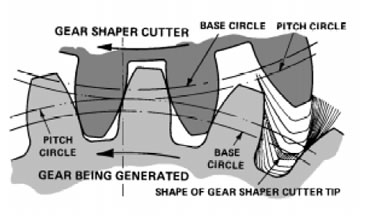WHAT IS GEAR SHAPING
 Gear Shaping is a machinery process that involves continuous, same-plane rotational
cutting. It is an accurate cutting process that produces a high surface finish on
both external and internal teeth. Shaping can generate many gear types including
spurs, involute splines, helical, herringbones, and racks. In addition to the versatility
of gear types produced, gear shaping also has the advantage of generating teeth
close to shoulders, whereas hobbing cannot. Similar to hobbing, gear shaping is
considered a generating process, but shaping is based upon the action of a cutter
mounted on a cutter-spindle and a gear blank held on an arbor or fixture on the
work-spindle. The cutter and work spindle, while driven by independent worm and
worm wheels, are tied together by change gears in order to keep the proper relation
between cutter and work. Synchronized as such, the cutter makes successive passes
through the blank generating a series of closely-spaced individual cuts. These rapidly
reciprocating successive passes by the cutter involve a downward ‘cutting’ and upward
‘relieving’ action. Each downward stroke is a cutting motion in which the cutter
and work are in mesh at the established infeed depth. On the return upward stroke
of the cutting tool, the work and shaper cutter are relieved to avoid rubbing the
work on a non-cutting surface of the shaper cutter.
Gear Shaping is a machinery process that involves continuous, same-plane rotational
cutting. It is an accurate cutting process that produces a high surface finish on
both external and internal teeth. Shaping can generate many gear types including
spurs, involute splines, helical, herringbones, and racks. In addition to the versatility
of gear types produced, gear shaping also has the advantage of generating teeth
close to shoulders, whereas hobbing cannot. Similar to hobbing, gear shaping is
considered a generating process, but shaping is based upon the action of a cutter
mounted on a cutter-spindle and a gear blank held on an arbor or fixture on the
work-spindle. The cutter and work spindle, while driven by independent worm and
worm wheels, are tied together by change gears in order to keep the proper relation
between cutter and work. Synchronized as such, the cutter makes successive passes
through the blank generating a series of closely-spaced individual cuts. These rapidly
reciprocating successive passes by the cutter involve a downward ‘cutting’ and upward
‘relieving’ action. Each downward stroke is a cutting motion in which the cutter
and work are in mesh at the established infeed depth. On the return upward stroke
of the cutting tool, the work and shaper cutter are relieved to avoid rubbing the
work on a non-cutting surface of the shaper cutter.
This generating process continues until the work piece has rotated 360 degrees at
the established infeed depth. At this point, another 360-degree rotation of the
work piece begins when a new infeed depth of cut is taken radially into the work
piece. When the cutter reaches the full depth for the given pitch required the desired
tooth form will have been produced.
Shaper cutters are essentially gears with relieved cutting edges that provide clearance
during the cutting process. Special features such as chamfering, topping, protuberance,
full radius, etc. can also be added into the tooth form of the cutter. These special
features will be directly dictated by what the work piece requires.

At Alpha Shaping there are two main types of shaper cutters we employ: disc type
and shank type. The shank type cutter is very useful in that it can be made with
a tapered shank for entrance into small bores or to bypass restricted space presented
by the work piece. The disc type cutter is the most common. The most rigid of the
two, the disc type allows for the most cutter load. A variation of the disc type
is a button cutter, dubbed so because of the small ½” or ¾” bore. Whether disc or
button, both are typically used in most external teeth applications and in many
internal applications. Special cutter spindle adapters can be used with these types
of shaper cutters that are made at varying shapes and lengths. At Alpha Shaping
we can create spindle adapters that fit to virtually any unique configurations we
encounter.
Some material & imagery referenced courtesy of
Ash Gear Co.